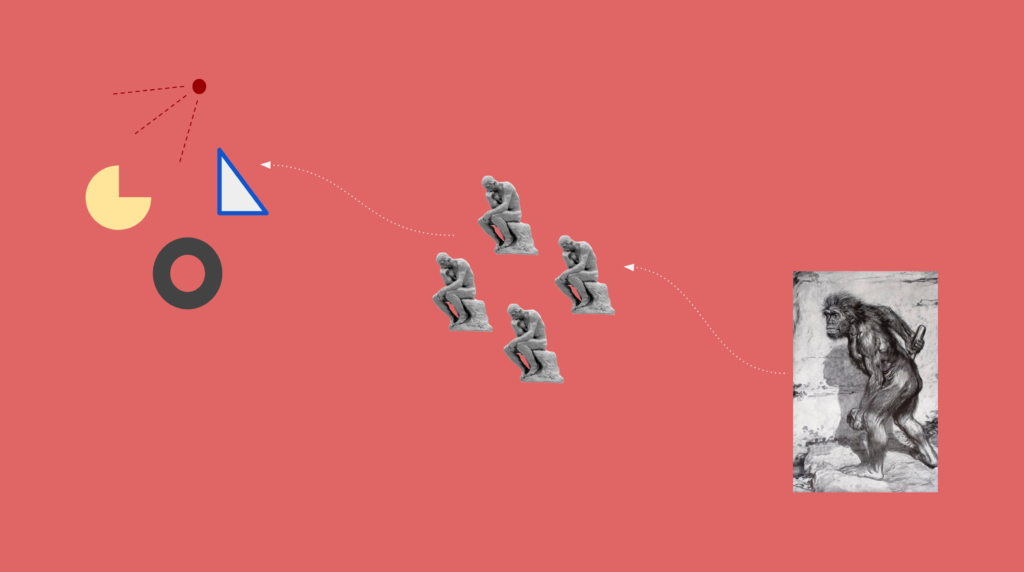
The paper Neanderthal Social Structure? by Brian Hayden written in 2012 [1] is very realistic and well founded.
The author pushes back on archeologists and anthropologists who still have a bias to describe Homo Neanderthalensis [2] as underdeveloped and with a limited social organization. I like the part where he wrote Such claims are based on contrived theoretical suppositions rather than empirical reality.
By reading and watching lectures by archeologists, anthropologists, and other scientists (e.g. the CARTA symposia [3]) I can’t help but notice the bias toward social idealization on one hand and brutification of archaic Homo on the other.
As I am not a scientist perhaps I have less of a duty to systematically map my inferences to more detailed evidence.
However, like I wrote before [4], I think there were big features that established a minimal level of evolution and social sophistication for Neanderthal. And, because I consider Neanderthal, Erectus, and Sapiens as the same species, I project such sophistication to much earlier in time to about 1.5 to 2 million years ago [5] [6].
Following are the big features I think are strong evidence of sophisticated social organization in archaic Homo.
Brain Size
The average brain size was 900 cc for Erectus, 1400 cc for Neanderthal, and 1300 cc for Sapiens. As the brain is the organ that requires most energy in the human species [7], I assume that cost would have been a death sentence for the genus Homo were it not for its usefulness for enhanced social interactions, social structure, and conflict minimization [8].
Skeletal Structure
As shown by the Turkana Boy fossil [9], Homo was practically anatomically modern since at least 1.5 to 2 million years ago. This means the evolution of hand dexterity, a body design for running and hunting, and larger cranium and brain, amongst other characteristics.
Footprints
The Koobi Fora Erectus footprints [10] are evidence of modern anatomy and soft tissue morphology consistent with an advanced anatomy. Also, it shows groupings in bands as described by Hayden’s paper for Neanderthal in the Middle Paleolithic, but in the Lower Paleolithic.
Monogamy
One of the things I liked the most about the paper were the group size estimates, which were bands of 12 to 24 members, local alliances of 10 to 20 bands, and macro groups of more or less 500 individuals.
However, the most fundamental unit is what the author mentioned as the “nuclear family”. It is estimated at 5 members per family, which is consistent with group growth and hence evolutionary pressure to grow the brain.
These groups are consistent with neurological studies [11] and Dunbar’s social brain hypothesis, brain, and group size estimates [12].
In my opinion, brain growth forced the nuclear family by forcing monogamy [13]. Monogamy enabled males to protect their offspring, the minimization of infanticide [14], and helped females who bore a huge cost in long care for their kids.
The nuclear family was basically the foundation of modern society.
Stone Tool Sophistication
I think the Acheulean stone tool industry is further affirmation [15] of the above in that it required anatomical features, manual dexterity, and intelligence, but also required a significant investment, knowledge, and cost to build [16].
Expansion Throughout Afro-Eurasia
The “worldwide” expansion of Homo Erectus [17] showed group growth as it increased conflict and pushed bands and clans away from each other (conflict is costly).
It also showed division of labour, and an ability to economically exploit the same resources (area, flora, and fauna) more efficiently. This division of labour was very likely seen in the production of costly stone tools.
It is very likely that some bands were specialists in stone tools and even protected and monopolized the areas where they found the right raw materials.
In other words, trade was forced into existence: Stone specialists needed to exchange their surplus for hunting rights or hunted products and skins, and non-stone specialists needed the stone tools to survive as well. This may have existed for water access rights as well, as other bands may have monopolized such access.
References
[1] Neanderthal Social Structure? – by Brian Hayden: http://etherplan.com/neanderthal-social-structure.pdf
[2] Neanderthal – by Wikipedia: https://en.wikipedia.org/wiki/Neanderthal
[3] Center for Academic Research and Training in Anthropogeny (CARTA) – Symposia Archive: https://carta.anthropogeny.org/symposia/past_list
[4] Evolution of Social Structure – by Donald McIntyre: https://etherplan.com/2020/08/27/evolution-of-social-structure/12515/
[5] Chama the Turkana Boy – by Donald McIntyre: https://etherplan.com/2020/10/10/chama-the-turkana-boy/12989/
[6] Analysis of Chama the Turkana Boy Story – by Donald McIntyre: https://etherplan.com/2020/10/15/analysis-of-chama-the-turkana-boy-story/13082/
[7] How Much Energy Does the Brain Use? – by Michael W. Richardson – BrainFacts: https://www.brainfacts.org/brain-anatomy-and-function/anatomy/2019/how-much-energy-does-the-brain-use-020119
[8] The Social Brain Hypothesis – by Robin I.M. Dunbar: http://etherplan.com/the-social-brain-hypothesis.pdf
[9] Turkana Boy – by Wikipedia: https://en.wikipedia.org/wiki/Turkana_Boy
[10] Homo Erectus Footprints at Koobi Fora – In The Footprints of Our Ancestors – by Dr. Brian Richmond: https://youtu.be/T1a9sQb8riE
[11] Molecular insights into human brain evolution – by Robert Sean Hill & Christopher A. Walsh: https://etherplan.com/molecular-insights-into-human-brain-evolution.pdf
[12] Neocortex Size, Group Size, and the Evolution of Language – by Leslie C. Aiello and R. I. M. Dunbar: http://etherplan.com/neocortex-size-group-size-and-the-evolution-of-language.pdf
[13] Monogamy – by Wikipedia: https://en.wikipedia.org/wiki/Monogamy
[14] Infanticide – Human Behavior – by Britannica: https://www.britannica.com/topic/infanticide
[15] Life history of a large flake biface – by Javier Baena Preysler, Concepcion Torres Navas, and Gonen Sharon: http://etherplan.com/life-history-of-a-large-flake-biface.pdf
[16] Hands-On Archaeology – by Ancient Technologies expert Allen Denoyer – Archaeology Southwest: https://www.youtube.com/playlist?list=PLnQ9uhFs_hq7N2WaiO-ZGbk9FpxSeLW9S
[17] Homo erectus – A Bigger, Smarter, Faster Hominin Lineage – by Adam P. Van Arsdale (Department of Anthropology, Wellesley College) – Nature Education: https://www.nature.com/scitable/knowledge/library/homo-erectus-a-bigger-smarter-97879043/